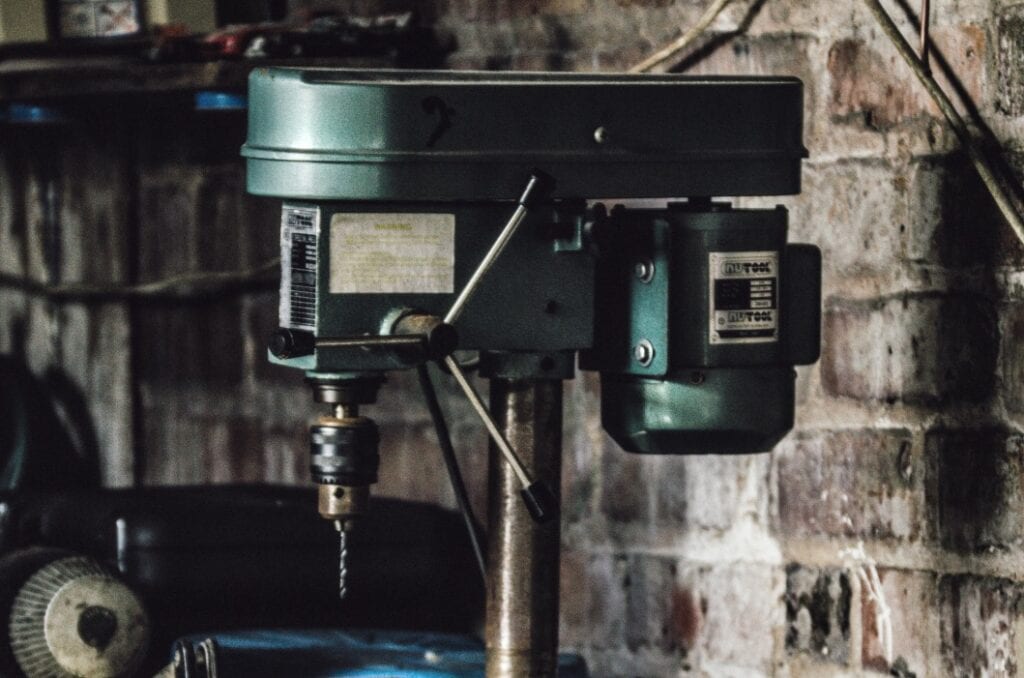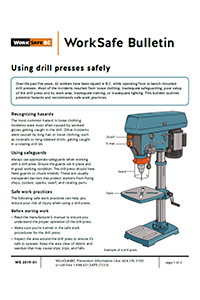When it comes to using a drill press, it’s important to be aware of the potential hazards. So, what are the hazards of a drill press? Let’s explore that in this article.
Drill presses are powerful machines that can make tasks like drilling holes easier and more efficient. However, if not used properly, they can pose a significant risk to your safety. Knowing the hazards associated with drill presses is crucial for any DIY enthusiast or aspiring woodworker.
In this article, we’ll delve into the potential dangers of using a drill press and offer some safety tips to ensure that you can use this tool effectively while minimizing the risks. So, let’s get started and uncover the hazards that come with operating a drill press.
When using a drill press, there are potential hazards to be aware of. These hazards include the risk of injury from rotating parts, such as the drill bit, and the possibility of getting clothing or hair caught in the machine. Additionally, there is a danger of electrical shock if proper safety precautions are not taken. It is important to wear protective eyewear, avoid loose-fitting clothing, and always follow the manufacturer’s instructions for safe operation.
What are the Hazards of a Drill Press?
Drill presses are powerful tools that are commonly used in woodworking, metalworking, and other industries. While they are extremely useful for drilling holes accurately, they also present certain hazards that need to be understood and mitigated. In this article, we will explore the potential dangers associated with drill presses and discuss safety measures that can be taken to prevent accidents and injuries.
Understanding the Risks: Safety Measures for Operating a Drill Press
Operating a drill press without proper knowledge and precautions can lead to serious accidents and injuries. It is crucial to understand the potential hazards and take appropriate safety measures to minimize the risk. Below are three key areas of concern when operating a drill press:
1. Rotating Parts
The rotating parts of a drill press, including the drill bit and the drill chuck, can cause injuries if not handled properly. The high speed and force of the drilling process can lead to accidental contact with the rotating parts, resulting in cuts, bruises, or even amputations. It is important to ensure that the drill press is switched off and unplugged before making any adjustments or changing the drill bit. When operating the drill press, always use the appropriate safety accessories such as safety goggles and gloves to protect yourself from flying debris.
Furthermore, it is essential to be mindful of loose clothing, jewelry, and long hair that can get caught in the rotating parts. Tying back loose hair, removing jewelry, and wearing fitted clothing are simple steps that can prevent serious accidents.
To avoid accidents related to the rotating parts, it is important to familiarize yourself with the specific safety guidelines provided in the drill press manufacturer’s manual. Always follow these guidelines and ensure proper training before operating a drill press.
2. Electrocution
Drill presses are typically powered by electricity, and improper handling of the electrical components can result in electrocution. To prevent this hazard, it is important to inspect the power cord for any fraying or damage before use. Avoid using the drill press in wet conditions or near water sources to eliminate the risk of electrical shock.
Additionally, it is essential to use a properly grounded electrical outlet and avoid using extension cords unless it is absolutely necessary. If the power cord or plug is damaged, it should be replaced immediately by a qualified professional to ensure the safety of the operator.
Regular maintenance and inspection of the electrical components of the drill press are crucial to prevent electrocution. It is recommended to have the drill press checked by a qualified electrician at regular intervals to identify and address any potential electrical issues.
3. Material Kickback
Material kickback occurs when the material being drilled is forcefully thrown back towards the operator. This can happen if the drill bit becomes jammed or if the material is not properly secured. To prevent material kickback, always ensure that the material is securely clamped to the worktable or held firmly in place.
It is also important to use the appropriate drilling speed and feed rate for the type of material being drilled. Using excessive force or incorrect techniques can increase the risk of kickback. Following the manufacturer’s recommendations for drill speed and feed rate can help prevent this hazard.
Furthermore, using sharp and properly maintained drill bits can reduce the chances of material kickback. Dull drill bits are more likely to cause the material to bind, increasing the risk of kickback.
Safe Operating Practices: Protecting Yourself and Others
Now that we have discussed the hazards associated with drill presses, it is important to emphasize the significance of adopting safe operating practices. Here are three key tips to ensure the safe use of a drill press:
1. Wear Personal Protective Equipment (PPE)
Always wear the appropriate personal protective equipment (PPE) when operating a drill press. Safety goggles or glasses will protect your eyes from flying debris, while gloves can provide a barrier against potential injuries. Additionally, wearing fitted clothing, tying back loose hair, and removing jewelry will minimize the risk of entanglement with the drill’s rotating parts.
2. Follow Proper Handling and Maintenance Procedures
Follow the manufacturer’s instructions for handling and maintaining the drill press. Regularly inspect the drill press and its components for any signs of wear or damage. Keep the drill press clean and free from dust or debris that may affect its performance. Lubricate the moving parts according to the manufacturer’s recommendations to ensure smooth operation.
3. Receive Proper Training
Before operating a drill press, make sure to receive proper training on its safe use. Familiarize yourself with the drill press’s features, functions, and safety guidelines. If you are not confident in your ability to operate the drill press safely, seek guidance and supervision from a qualified individual.
In summary, while drill presses are invaluable tools for various applications, it is crucial to be aware of the potential hazards they pose. By understanding the risks associated with rotating parts, electrocution, and material kickback, and by following safe operating practices, we can minimize the likelihood of accidents and injuries. Always prioritize your safety and the safety of others when operating a drill press.
Key Takeaways: What are the hazards of a drill press?
- A drill press can cause serious injuries if not used properly.
- Accidental contact with moving parts can result in finger or hand injuries.
- Loose clothing or jewelry can get caught in the drill press, leading to injury.
- Using excessive force can cause the drill bit to break, posing a risk of flying debris.
- Failure to secure the workpiece properly can lead to it spinning or being ejected.
Frequently Asked Questions
When working with a drill press, it’s important to be aware of the potential hazards to ensure your safety. Here are some frequently asked questions about the hazards of a drill press:
1. What are the potential hazards of a drill press?
Drill presses can pose several hazards if not used properly. The most common hazards include:
First, there is a risk of injury from moving parts. The spindle and chuck can rotate at high speeds, and if fingers, hair, or loose clothing get caught, there is a possibility of severe injury. Second, there is a danger of kickback. If the material being drilled binds or catches the bit, it can cause the workpiece to suddenly spin or jump, potentially causing harm. Lastly, there is also the risk of inhaling dust or debris generated while drilling, which can be harmful to the lungs if proper precautions are not taken.
2. How can I prevent injuries from moving parts on a drill press?
To prevent injuries from moving parts on a drill press, it’s crucial to take the following precautions:
First, always ensure that long hair is tied back, and loose clothing or jewelry is secured to avoid entanglement with the rotating parts. It’s also essential to keep your fingers and hands away from the dangerous zones, such as the rotating chuck and spindle. Whenever possible, use proper safety guards and devices, such as a spindle guard or a drill press vise, to minimize the risk of accidental contact. Additionally, be cautious when changing bits or adjusting the workpiece to avoid any unintentional contact with the moving parts.
3. How can I prevent kickback when using a drill press?
To prevent kickback on a drill press, consider these safety measures:
First, always securely clamp the workpiece to prevent it from moving during the drilling process. This ensures better control and reduces the risk of kickback. Secondly, use appropriate cutting tools and drill bits that are specifically designed for the material you are working with. Using the wrong type of bit can increase the chances of binding and kickback. Additionally, maintain a firm grip on the material being drilled and take care to avoid applying excessive pressure, as this can also increase the likelihood of kickback. Lastly, be sure to adjust the drill press speed based on the material being drilled, as higher speeds can lead to more frequent kickback incidents.
4. What precautions should I take to avoid inhaling dust or debris while using a drill press?
To minimize the risk of inhaling dust or debris while using a drill press, you can follow these precautions:
First, always work in a well-ventilated area. If possible, use a drill press in a dedicated workshop space or outdoors to ensure proper airflow. Additionally, wear a dust mask or respirator to filter out harmful particles and prevent inhalation. Using a dust collection system or attaching a dust extractor to the drill press can also help to remove airborne particles. Lastly, be mindful of the material you are drilling and make sure to choose the appropriate drill bits to reduce dust and debris production.
5. Are there any other general safety tips for using a drill press?
Yes, here are some general safety tips to keep in mind when using a drill press:
First, always read and follow the manufacturer’s instructions and safety guidelines before operating the drill press. Familiarize yourself with the specific features and limitations of your machine. Second, wear appropriate personal protective equipment (PPE), such as safety goggles and ear protection, to safeguard your eyes and ears from potential hazards. Third, maintain a clean and organized work area, free from clutter or obstructions that could interfere with safe operation. Lastly, it’s crucial to practice good judgment and common sense. If you’re unsure about a specific procedure or feel uncomfortable, seek guidance from a more experienced user or consult the instruction manual. Safety should always be the top priority when working with power tools like a drill press.

Summary
So, to sum it all up, drill presses can be dangerous if not used properly. It’s important to wear safety goggles to protect your eyes from flying debris. Keep your fingers away from the moving parts and use the machine’s guard for added protection. Remember to secure your workpiece and use the correct drill bit for the material you’re working with. And most importantly, always ask a parent or adult for guidance and supervision when using a drill press.
In conclusion, while a drill press can be a useful tool, it’s crucial to prioritize safety to avoid accidents or injuries. Follow these tips and guidelines to keep yourself and others safe when using a drill press.
